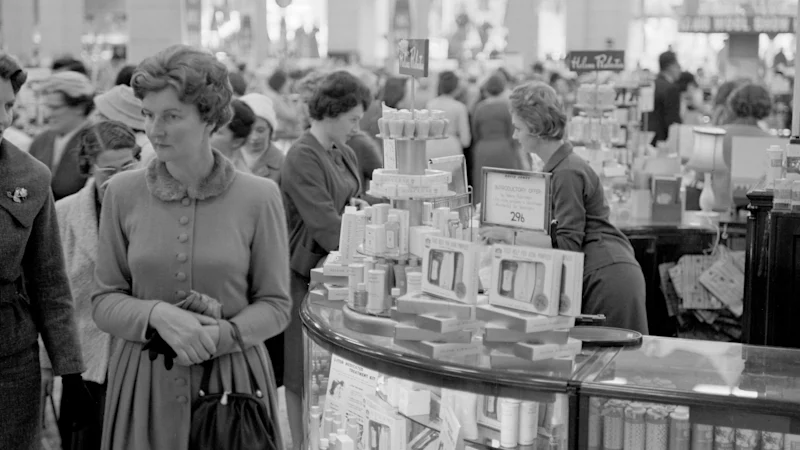By Stephanie Wood
Copyright smh

Increasingly though, what matters are the new high-velocity shoppers – especially young women – whose purchasing decisions are driven by algorithms, influencers and internet buzz. “It’s all about the newness we deliver, whether it’s fresh collections from existing brands, which then trigger digital sales, or getting new brands online and in store,” says Veals, adding that each year in women’s wear, about 100 new brands come online. She tells me that, after our interview ends, she will take one of the owners of Anchorage Capital through her departments, including to intimate apparel, a growing area, “to show him some of the new things that we’ve got”. Recent arrivals exclusive to David Jones include the inclusivity-focused Nala range; Marks & Spencer briefs, bras, thongs and “bum-boosting” shorts (“Marks & Spencer are probably the best in the world for making underwear and intimate apparel,” says Veals); and Kim Kardashian’s shapewear and underwear brand, SKIMS (I find no sign on the David Jones website that the SKIMS bandage-like “seamless sculpt face wrap” with its chin strap and “collagen yarn” for overnight wear is available).
If women’s wear is a high note, other categories are less successful for both David Jones and Myer. Beauty, for example. “We probably lost our way in terms of beauty, so that’s an opportunity for us,” says David Jones’s Scott Fyfe. Meanwhile, Myer’s Olivia Wirth notes that beauty services are “next-level” in overseas department stores such as Selfridges and Galeries Lafayette. She poses the question: “Increasingly, younger customers want to be able to test the product, do it with their friends; so what is the sort of space that you want there … how do you bring those beauty services front and centre?”
‘More than 80 per cent of Gen Z prioritises real-world experiences over digital ones … Department stores need to offer the wow factor.’Patty Huntington, fashion journalist
Both bosses will be studying Mecca’s moves: Australia’s most dominant beauty retailer, founded by Jo Horgan, has more than 100 stores and, in 2023, surpassed $1 billion in revenue for the first time. In August, rapturous customers started queuing at 4am for the opening of Mecca’s new three-level flagship megastore in Melbourne’s Bourke Street mall. Billed as “the most spectacular beauty store on earth”, it includes hair and nail salons, brow and lash services, a high-tech skin clinic, a fragrance “Scentsorium”, piercing services and even an in-house naturopath and “Beauty Atelier”, whatever that might be. The irony is unlikely to have escaped the department store bosses: the Mecca pleasuredome has taken over the space that the David Jones menswear store once occupied.
But it’s far from the only competitor the department stores are watching. In beauty, the French multinational chain Sephora is also a force, with more than 20 stores in Australia and New Zealand. Fashion competitors include the Japanese retailer Uniqlo and the European brand Cos, both big players with substantial footprints. “It’s a perfect storm of competition for department stores,” says Patty Huntington. “There’s almost a Cos-ification of fashion going on – their stuff looks like what’s on the runways at a fraction of the price – and Uniqlo does capsule designer collaboration collections which can sell out immediately.” In shopping centres outside the city centre where one or both department stores are anchoring tenants, there are more speciality shops across a range of categories than there have ever been.
The biggest hurdle for the companies might be younger consumers, whose shopping habits are profoundly different from their parents and grandparents, and for whom department stores are like foreign countries. But Huntington believes that in those differences lie opportunities. “According to multiple reports, more than 80 per cent of Gen Z prioritises real-world experiences over digital ones. Teenage girls are obsessed with Mecca. Department stores need to offer the wow factor as Jo Horgan has done.”
Luring younger customers
David Jones’ boss Scott Fyfe grew up in Aberdeen, Scotland, and remembers Christmas at John Lewis department store. “It was twinkly, it was magical, it had the biggest Christmas tree.” His counterpart at Myer, Olivia Wirth, recalls childhood trips from the Central Coast to Sydney’s Grace Bros, acquired by Myer in 1983. “So many people tell me about their fantastic experiences shopping with their grandmother, or coming into the city for a department store experience.” But fond memories won’t ensure department stores’ survival. As Wirth notes, the questions are: “How do you continue to make it more relevant to a broad cross-section of customers, how do we bring in the younger customer?”
The biggest lever might be loyalty: Myer One already has 4.6 million active members and is widely regarded as one of the world’s best loyalty programs. Wirth, who ran Qantas’s powerhouse Loyalty business before joining Myer in early 2024, says Myer One was a major lure for her. “I was interested in the role that it played for the business but, more importantly, what role it could play in the future.” She says that after her arrival, in internal discussions about the program’s future, “we were looking globally, and we were looking beyond retail.” When Myer One relaunches in October, Wirth says that customers can expect a sharper digital experience. Shoppers at Myer’s recently acquired Apparel Brands outlets will also be able to earn and redeem MyerOne points. “We’ve got a job to do in terms of reimagining Myer, really making sure that we integrate the new businesses and get the synergies … we believe that we’re building out a retail platform here.”
Meanwhile, David Jones is pressing ahead with Vision 2025+, the strategy devised under CEO Scott Fyfe to transform the brand. It charts a course for the company to become, in corporate speak, “an integrated omnichannel curator” of top brands, to deliver “seamless” service and experiences across its 40 stores and online, and to “know and grow” its customer base. To date, $65 million has gone into upgrading the company’s technology. Another $100 million is earmarked for store refurbishments over the next two years. Central to the transformation are two firsts for the business: a mobile shopping app, launched late last year, and the store’s first ever points-based loyalty program, David Jones Rewards, launched with a runway show of the spring-summer collections at Hangar 96 at the Qantas domestic terminal in Sydney last Thursday.
“Are we behind other retailers [in the development of a loyalty program]? Yes, we are,” says Scott Fyfe, who left a senior executive post at Marks & Spencer in London to helm Country Road Group before joining David Jones in 2020. “Why have we partnered with someone like Qantas? Because we believe that will give us the firepower to really catch up with some of our key competitors.” His target: 3 million members. And the brand still has a sheen of gold dust: “friends of David Jones” include Megan Gale, Adam Goodes and Julie Bishop (contractual details are confidential, the company says) – while the “face” of David Jones Rewards is an AI-generated dalmatian, a 2025 take on the company’s long-standing brand code and symbol of loyalty.
But despite loyalty program launches and relaunches, refurbishments and reimaginings, omnichannels and synergies, the future for department stores remains uncertain, especially for the bricks-and-mortar stores.
Scott Fyfe thinks that in the decades ahead, there will still be flagship David Jones stores in the cities and in “the right shopping centres”. Olivia Wirth says stores will not remain in their existing format. “There is a way for us to reimagine what that format should be [but] it doesn’t matter whether you’re a 16-year-old or a 60-year-old, research shows that people want a shopping experience, whether it’s about getting the right fit or smelling different fragrances.” One market analyst I speak to says that as the department stores’ relevance shrinks, a merger of the two is a potential outcome. “The clear trend over the last decade has been that Australian consumers have chosen to shop elsewhere,” he says.
For now, though, loyal customers remain. Jaynie Anderson booked a personal styling appointment at David Jones ahead of a recent trip to Europe. She needed advice on a nice new suit. Miranda Cole’s daughter was married in the Myer Mural Hall in 2014. Cole and her husband, Max, still regularly go into the city store. “Max will sit and have a cocktail or two in the Salon Champagne Bar and I will go and shop, then come back for a sip and a chat,” says Cole. “Myer has always been part of our world.”
To read more from Good Weekend magazine, visit our page at The Sydney Morning Herald,The Age and Brisbane Times.



